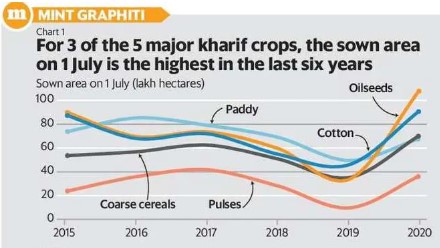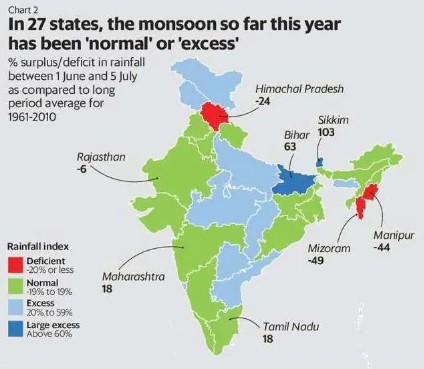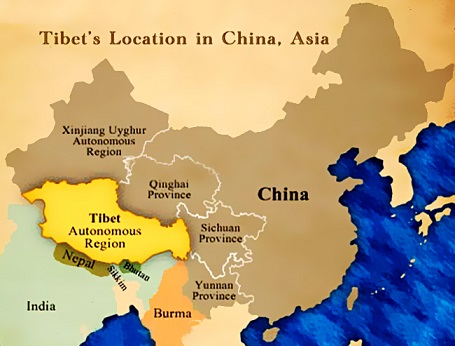Contents
- 2020 may be a Bumper Harvest Year
- Quorum not needed for routine standing committee meetings
- UAE in support of open skies agreement with India
- UGC: Safety norms drawn up for university exams
- U.S., China trade visa curbs over Tibet
2020 MAY BE A BUMPER HARVEST YEAR
Focus: GS-III Environment and Ecology, Prelims
Why in news?
India’s troubled agricultural sector, which employs about 60% of its workforce and contributes about 16% to its economic output, is set to record its best performance in recent years.

Why is the agriculture sector expected to perform well?
Monsoon Rains
- Substantial pre-monsoon showers in May 2020, followed by a timely onset of rains over the entire country, have spurred sowing across all major monsoon crops.
- Four of the five major monsoon crops saw an increase in the sowing area over their respective five-year average nationally.
- A combination of factors is behind the favourable farm conditions. Two cyclones, Amphan and Nisarga, struck on either coast in the pre-monsoon period. While they caused widespread destruction, they also brought significant rains to large swathes of India, paving way for early sowing of Kharif crops.
- Rains have been abundant and, more significantly, distributed well, and according to the India Meteorological Department (IMD), 27 states and union territories recorded ‘normal’ or ‘excess’ rainfall in July 2020.
- The kharif season (June to September) sees the sowing of crops such as paddy, millets, and especially pulses, oilseeds and cotton, which are predominantly rain-fed.

Reservoir capacity
- With reservoirs holding nearly twice as much water as last year, and a favourable monsoon forecast, it augurs well for enhanced agricultural productivity.
- Extreme monsoon caused severe floods in Kerala, Karnataka, Bihar and the North-East. However, this ensured the reservoirs were replenished.
- Reservoirs are crucial to irrigated kharif crops such as paddy, which require standing water.
COVID-19 Lockdown
- While most economic activity was at a standstill due to the covid-induced lockdown, farming was allowed to continue.
- With migrants returning from cities to their rural homes, additional hands in the farm may have also contributed to a greater labour pool.
-Source: Livemint
QUORUM NOT NEEDED FOR ROUTINE STANDING COMMITTEE MEETINGS
Focus: GS-II Polity and Governance
Why in news?
The officials at the Rajya Sabha secretariat has said that quorum was essential only when the committees are taking decisions or adopting reports and not during routine deliberations.
Details
- Out of 281 meetings of the eight department-related standing committees that are headed by Rajya Sabha members, 16 per cent were held without quorum.
- Point isn’t about quorum alone, it’s also about facilitating those MPs who want to attend and are unable to because of containment zones & quarantine restrictions in their home states.
Quorum in India
- A quorum is the minimum number of members of a parliamentary assembly necessary to conduct the business of that group.
- Article 100 of the Constitution of India stipulates that at least 10% of total number of members of the House must be present to constitute the quorum to constitute a meeting of either House of Parliament.
- For example, if the House has the total membership of 250, at least 25 members must be present for the House to proceedings with its business.
- If at any time during a meeting of a House there is no quorum, the Chairman/Speaker has to either adjourn the House or suspend it until there is a quorum.
-Source: The Hindu
UAE IN SUPPORT OF OPEN SKIES AGREEMENT WITH INDIA
Focus: GS-II International Relations
Why in news?
The UAE is keen to have an open sky agreement with India.
Significance of the Open Sky Agreement between India and UAE
- There are more than 1,000 flights a week between India and the UAE operated by the airlines of the two countries under the bilateral Air Service Agreement.
- There are about 1,068 flights a week between India and the UAE operated by the airlines of the two countries under the bilateral Air Service Agreement.
- India has Air Service Agreements (ASA) with 109 countries including UAE covering aspects relating to the number of flights, seats, landing points and code-share. But does not allow unlimited number of flights between two countries.
- Open skies between India and UAE will now allow unlimited number of flights to the selected cities of each other’s countries.
Fifth and Sixth Freedom of Air
- UAE also mentioned that it does not intend to implement fifth and six freedoms of air, and where the interest of Indian airlines will be threatened by other air carriers.
The Freedom of air was formulated as a result of disagreements over the extent of aviation liberalisation in the Convention on International Civil Aviation of 1940s, known as the Chicago Convention.
- The fifth freedom of air includes the right to fly between two foreign countries on a flight originating or ending in one’s own country.
- The sixth freedom of air includes the right to fly from a foreign country to another while stopping in one’s own country for non-technical reasons.
India’s Open Sky Policy
- Open Sky Agreements are bilateral agreements that the two countries negotiate to provide rights for airlines to offer international passenger and cargo services. It expands international passenger and cargo flights.
- The National Civil Aviation Policy (2016) allows the government to enter into an ‘open sky’ air services agreement on a reciprocal basis with South Asian Association for Regional Cooperation (SAARC) nations as well as countries beyond a 5,000 kilometre radius from New Delhi.
-Source: The Hindu
UGC: SAFETY NORMS DRAWN UP FOR UNIVERSITY EXAMS
Focus: GS-II Governance
Why in news?
HRD Ministry sends guidelines to NTA, UGC and AICTE as the Centre wants universities to take to safeguard students taking examinations physically.
Details of Measures
- Two-meters space between examination desks;
- Disinfection of walls, floors and doors;
- Thermometers and sanitisers at all entry and exit points;
- Students having symptoms such as fever, cough and cold should “either be made to sit in a separate room or given a chance to appear on another day”;
- Staff conducting exams must self-certify their health status and submit to temperature screening.;
- Frequently touched surfaces like doors at all examination centres to be sprayed with disinfectant;
- All students must wear face masks and clean their hands;
- Staff must wear masks and gloves.
-are some of the major measures notified.
However, many students are still apprehensive about health risks.
Recently in news: Student bodies protest against UGC guidelines mandating exams.
University Grants Commission along with Ministry of Human Resource Development had released Standard Operating Procedure (SOP) for conducting the final year or end-semester examination.
The SOP said All states should conduct exams for final year students.
University Grants Commission (UGC)
- The University Grants Commission of India (UGC India) is a Statutory Body set up by the Government of India in accordance to the UGC Act 1956.
- UGC is charged with coordination, determination and maintenance of standards of higher education.
- UGC is set up under the Ministry of Human Resource Development (MHRD).
- It provides recognition to universities in India, and disbursements of funds to such recognized universities and colleges.
- UGC is modelled after University Grants Committee of UK which was an advisory committee of the British government.
Accreditation for higher learning over Universities under the aegis of University Grants Commission is overseen by other autonomous statutory institutions such as:
- All India Council for Technical Education (AICTE)
- Distance Education Council (DEC)
- Indian Council of Agricultural Research (ICAR)
- Bar Council of India (BCI)
- National Council for Teacher Education (NCTE), etc.
Future of UGC
- In 2018, the Ministry of Human Resource Development announced its plans to repeal the UGC Act, 1956.
- The bill also stipulates the formation of a new body, the Higher Education Commission of India (HECI).
-Source: The Hindu
U.S., CHINA TRADE VISA CURBS OVER TIBET
Focus: GS-II International Relations
Why in news?
The U.S. and China imposed visa restrictions on each other over their disagreement on Tibet, adding fuel to the diplomatic fire between the superpowers.
Details
China announced its curbs on people from the U.S. who “behave badly” on Tibet-related issues.
U.S. Moves
- U.S. Secretary of State had announced visa restrictions for a certain group of Chinese officials under the Reciprocal Access to Tibet Act.
- According to U.S. Beijing has continued systematically to obstruct travel to the Tibetan Autonomous Region (TAR) and other Tibetan areas by U.S. diplomats and other officials, journalists, and tourists, while Chinese officials and other citizens enjoy far greater access to the United States.
- Amid high tension with China, the U.S. has increasingly been issuing such visa sanctions, earlier taking action over Beijing’s clampdown on free expression in Hong Kong and its incarceration of some one million Uighurs.
- The Tibet action comes under a 2018 law passed by Congress that aims to pressure China over its tight restrictions in the Himalayan region.
- The International Campaign for Tibet, a rights advocacy group close to the Dalai Lama, welcomed the implementation of the law.
- The U.S. action comes right after the 85th birthday of the Dalai Lama, who has spent most of his life in exile in India.
- The campaign said it saw momentum, pointing to a recent joint call by 57 European parliamentarians from 19 countries to set up their own version of the Reciprocal Access to Tibet Act.
China Moves
- China expressed firm opposition to the move and urged the U.S. to immediately stop interfering in China’s internal affairs through Tibet-related issues.
- Beijing has largely barred foreign journalists from visiting Tibet since 2008.
Tibet

Geography
- Tibet is a region on the Tibetan Plateau in Asia, spanning to nearly a quarter of China’s territory.
- It is the traditional homeland of the Tibetan people as well as some other ethnic groups.
- Tibet is the highest region on Earth, with an average elevation of 4,900 metres. The highest elevation in Tibet is Mount Everest.
History
- From 1912 until the founding of the People’s Republic of China in 1949, no Chinese government exercised control over what is today China’s Tibet Autonomous Region (TAR).
- Many Tibetans insist they were essentially independent for most of that time and have protested what they regard as China’s rule imposed after the People’s Liberation Army occupied TAR in 1950.
- The Dalai Lama’s government alone ruled the land until 1951. Tibet was not “Chinese” until Mao Zedong’s People’s Liberation Army (PLA) marched in and made it so.
India and Tibet
- Apart from the border disputes, another major irritant for China has been over the Dalai Lama, who enjoys a spiritual status in India.
- China considers Dalai Lama a separatist, who has great influence over Tibetans. It must be mentioned that Dalai Lama gave up his support for Tibetan independence in 1974, and only wants China to stop repression against the community.
- The Government of India has built special schools for Tibetans that provide free education, health care, and scholarships. There are a few medical and civil engineering seats reserved for Tibetans.
- While India’s role in the rehabilitation of Tibetan refugees has been criticised by China, it has drawn praise from international bodies and human rights groups.
Click Here to read more about the ‘Five Fingers’ of Tibet policy (2nd Article)
-Source: The Hindu





